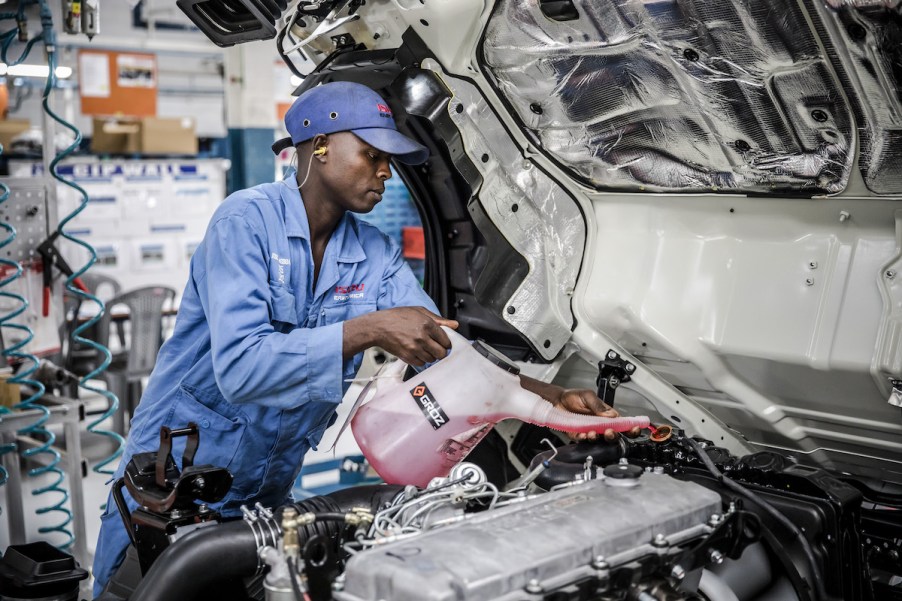
Car Fluids 101: Are Antifreeze and Coolant the Same?
Owning a vehicle requires some knowledge of car care and maintenance. For instance, you should know what fluids your vehicle needs replaced and topped off regularly. Two of them are antifreeze and coolant. Do you know the difference and how to use each properly?
What is the difference between antifreeze and coolant?

Some people use “coolant” and “antifreeze” interchangeably. But these two car fluids are not exactly the same.
According to Cars.com, antifreeze contains ethylene glycol or propylene glycol. This essential fluid needs to be mixed with water to become a coolant. In turn, coolant is found in the cooling systems of water-cooled cars.
Typically, coolant is mixed with water at a ratio of 50/50. It provides suitable cooling for engines that operate at more than 200 degrees Fahrenheit and prevents freezing in temperatures down to 30 degrees below zero. In much colder climates, you might see up to 70% antifreeze in the mix.
Water by itself will not provide enough cooling because it boils at 212 degrees Fahrenheit and freezes at 32 degrees. Water can also rust a vehicle’s cooling system parts.
Likewise, antifreeze alone won’t provide enough protection against freezing. Antifreeze freezes at zero degrees. But, if you mix antifreeze with water, creating a coolant, at a 50-50 ratio, the freezing point drops to 35 degrees below zero and raises the boiling point to at least 223 degrees.
These freezing and boiling points are vital because you don’t want your engine to freeze over or overheat during the harsher seasons of the year. Coolant is also important when there’s something else going on under the hood that could cause the temperature to rise. This fluid can help protect against further damage.
Different cars require different types of coolant to work correctly. To top off your vehicle’s fluids, you must know exactly which coolant your model needs. You can find this information in the vehicle owner’s manual.
The colors of antifreeze and coolant matter
If you’ve ever shopped for antifreeze or coolant, you’ve probably noticed the different colors. Typically, coolant is green, but you can also find orange, blue, purple, yellow, and even pink. These colors are not just for aesthetics.
Each car manufacturer designs its engines with a specific coolant or antifreeze. For example, General Motors uses an orange-colored Dex-Cool antifreeze, but Volkswagen uses coolants that are typically yellow or blue.
It’s important to remember that these colors are developed based on different chemistries. Mixing the various colors cause chemical reactions that can severely damage a car’s system.
Though you might see conflicting information about mixing coolants, avoiding combining them is a good rule of thumb. Also, consult your vehicle’s owner’s manual to learn which type of antifreeze your model needs.
How to check your car’s antifreeze
You can take a few maintenance steps to keep your vehicle in tip-top shape. One of them is checking your car’s antifreeze. An easy indicator you need to check your antifreeze is if you notice a cloud of steam and a dead engine. But let’s hope you won’t get to that point.
Here are a few easy tips for checking your car’s antifreeze:
- Locate and remove the radiator cap. Ensure you do not touch the cap if it’s warm or the engine is still running.
- Check for brown residue under the radiator cap. This sludge can indicate the need for a change.
- Use a flashlight to look inside the radiator. Check to see if it is brown and thick or has particles. Both point to the need for a change.
- Look at the coolant reservoir. Your coolant is probably OK if the color is still vibrant.
- Stick a hydrometer in the coolant reservoir. If the antifreeze is well below 35 degrees Fahrenheit, it’s probably time for a change.


